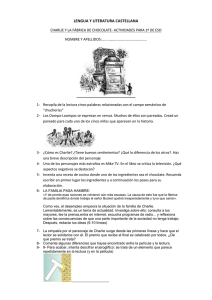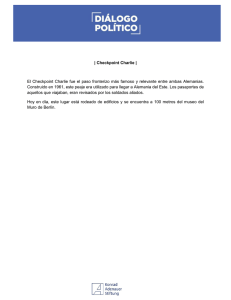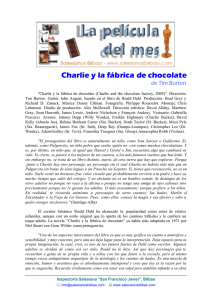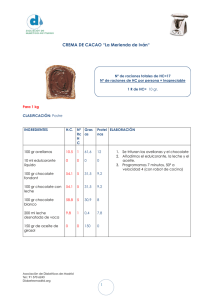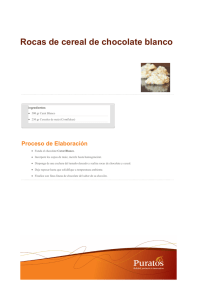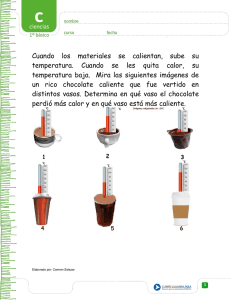Propuesta didáctica para la película ,Charlie and the Chocolate
Anuncio
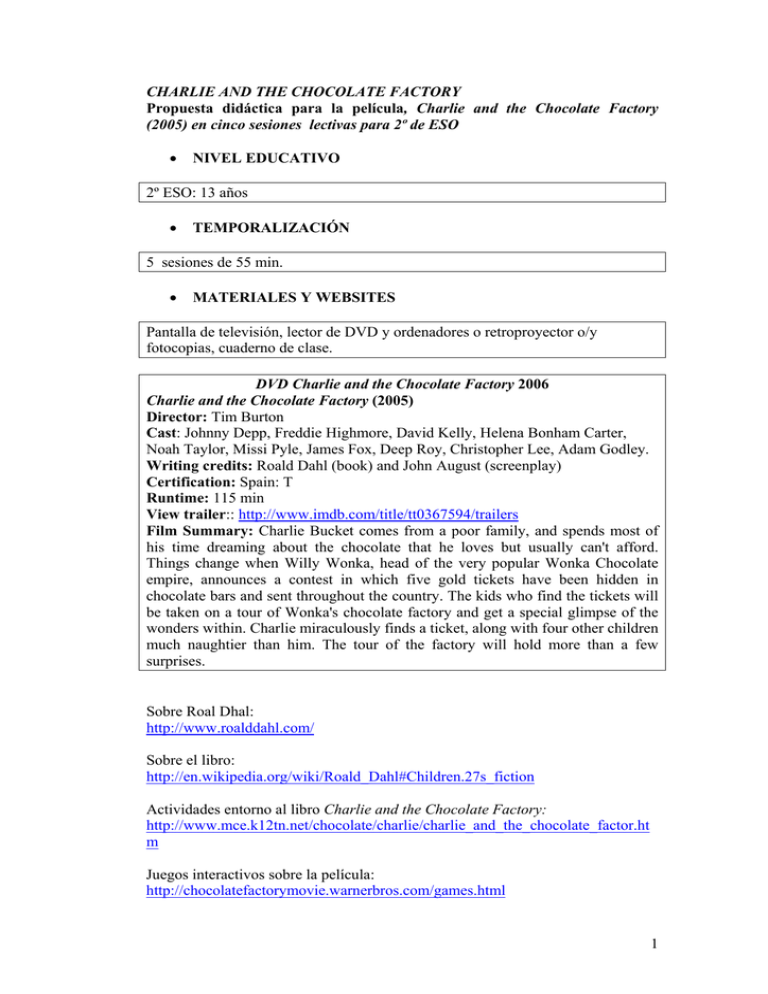
CHARLIE AND THE CHOCOLATE FACTORY Propuesta didáctica para la película, Charlie and the Chocolate Factory (2005) en cinco sesiones lectivas para 2º de ESO • NIVEL EDUCATIVO 2º ESO: 13 años • TEMPORALIZACIÓN 5 sesiones de 55 min. • MATERIALES Y WEBSITES Pantalla de televisión, lector de DVD y ordenadores o retroproyector o/y fotocopias, cuaderno de clase. DVD Charlie and the Chocolate Factory 2006 Charlie and the Chocolate Factory (2005) Director: Tim Burton Cast: Johnny Depp, Freddie Highmore, David Kelly, Helena Bonham Carter, Noah Taylor, Missi Pyle, James Fox, Deep Roy, Christopher Lee, Adam Godley. Writing credits: Roald Dahl (book) and John August (screenplay) Certification: Spain: T Runtime: 115 min View trailer:: http://www.imdb.com/title/tt0367594/trailers Film Summary: Charlie Bucket comes from a poor family, and spends most of his time dreaming about the chocolate that he loves but usually can't afford. Things change when Willy Wonka, head of the very popular Wonka Chocolate empire, announces a contest in which five gold tickets have been hidden in chocolate bars and sent throughout the country. The kids who find the tickets will be taken on a tour of Wonka's chocolate factory and get a special glimpse of the wonders within. Charlie miraculously finds a ticket, along with four other children much naughtier than him. The tour of the factory will hold more than a few surprises. Sobre Roal Dhal: http://www.roalddahl.com/ Sobre el libro: http://en.wikipedia.org/wiki/Roald_Dahl#Children.27s_fiction Actividades entorno al libro Charlie and the Chocolate Factory: http://www.mce.k12tn.net/chocolate/charlie/charlie_and_the_chocolate_factor.ht m Juegos interactivos sobre la película: http://chocolatefactorymovie.warnerbros.com/games.html 1 Para saber más sobre la película: • INTRODUCCIÓN La película Charlie and the Chocolate Factory puede despertar el interés por el libro en que está basada así como por otras obras de Roal Dhal. Es especialmente interesante, Boy: Tales of Childhood, que se podría leer en castellano como actividad intercurricular entre la clase de Lengua Castellana y de Inglés. Figuraría en las lecturas sugeridas en la asignatura de Lengua Castellana y se podrían trabajar alguna selección de frases o pequeños fragmentos en la de Inglés. Esta misma propuesta se podría hacer con The Witches (1983) Film: The Witches (1990) y traducida como Las Brujas en la edición castellana de Alfaguara. En cuanto a la selección del idioma, el DVD Charlie and the Chocolate Factory cuenta con subtítulos en castellano y en inglés, por lo que todo dependerá de la buena aceptación para leer subtítulos y del nivel de inglés de cada clase específicamente. • OBJETIVOS Fomentar la lectura en castellano de Dhal Conocer los títulos en inglés de la obra infantil-juvenil de Dhal Conocer la infancia de Dhal Saber que la película es una adaptación literaria y que ya hubo otra película anterior Repasar aspectos gramaticales: practicar el past simple de verbos regulares e irregulares, identificar comparativos y superlativos. Pronunciación de ch/sh Vocabulario: uso de adjetivos para descripciones. Educar en valores: Los malos hábitos de los niños maleducados. • CONTENIDOS 1. REFLEXIONES SOBRE LA LENGUA 1.1 FUNCIONES DEL LENGUAJE Y LA GRAMÁTICA Estructuras: Uso de simple past, afirmativa, negativa e interrogativa Verbos regulares e irregulares. Comparativos y superlativos . Procedimientos Reading: “The Boy Roald Dhal”, fragmento de la película, “Dhal’s books for children”, ”how good is your memory”, “who is who?.” 2 Speaking: “Did you know any of these tittles, which ones?” “When did you read the books or see the fims?” Writing: “Answer these questions writing complete sentences”, Copy all the comparatives and superlatives you find in these texts into your notebook. Actitudes Entender que una clase no es una sala de cine y que la película es una ocasión para aprender inglés por lo que hay que esforzarse y leer subtítulos en lugar de comer palomitas. Participar en una actividad común venciendo la timidez de algunos para cantar en público o recitar. Aprender a no reírse de los compañeros/as cuando canten. 1.2 VOCABULARIO Uso de adjetivos para descripciones: ordinary, little, faster, stronger, more clever, rich, powerful, wellconnected, luckiest, entire, the most amazing, the most fantastic, the most extraordinary. Vocabulario sobre la comida: grocery store , sweet jar, ice cream, Sunday meal, served meat, dessert… 1.3 FONÉTICA ch: Charlie, chocolate/ sh: she, Sheila Recitar o cantar versos de la canción "Violet Beauregarde..." Tomar conciencia de la rima por su sonido no por la ortografía de las palabras. 2. ASPECTOS SOCIOCULTURALES Conocer la obra de infantil-juvenil de Dhal Educar en valores: Los malos hábitos de los niños en los países ricos en el s.XXI. y el desprecio a los demás. • DESARROLLO DE LAS ACTIVIDADES: PRIMERA SESIÓN (50’) Actividad 1: 35 min. Se proyecta en la pared, pantalla del ordenador o fotocopia el doc CATCF1. Se resuelven las preguntas si las hay, se traducen las palabras nuevas y se pide que las copien con su traducción correspondiente en los cuadernos. The boy Roald Dahl 3 Roald Dahl was born in Wales in 1916, to Norwegian parents He was named after the polar explorer Roald Amundsen, a national hero in Norway at the time. In 1920, when Roald was four, his seven-year-old sister, Astri, died from appendicitis then about a month later his father died of pneumonia. But his mother did not come back to Norway. Roald first attended Llandaff Cathedral School. At the age of eight, he and four of his friends put a dead mouse in a jar of sweets at the local sweet shop owned by a “horrible” old woman called Mrs. Pratchett. The headmaster of Llandaff Cathedral School punished them. After that his mother sent him to several boarding schools, which was an unpleasant experience for him and his friends. He was very homesick and wrote to his mother almost every day. At Repton School in Derbyshirehe he was captain of the school Squash team, and played for the football team. He also developed an interest in photography. Cadbury, a chocolate company sometimes sent boxes of new chocolates to Repton School and the students tasted them. Dahl dreamed of inventing a new chocolate bar and won the praise of Mr. Cadbury himself, and this was the inspiration for his third book for children, Charlie and the Chocolate Factory. During his childhood and adolescent years he spent his summer holidays in his parents' native Norway. Hi did not go to university after leaving school, Dahl found a job with Shell Petroleum Company which sent him to other parts of the world. His childhood is the subject of his autobiographical work, Boy: Tales of Childhood Se proyecta en la pared, pantalla del ordenador o fotocopia el doc CATCF2, se realizan y se corrigen los ejercicios Underline all the past tenses you can find in the text, after that divide them into two groups: regular and irregular verbs and write them into two columns. Answer these questions writing complete sentences Where and when was he born? Where did his parents come from? Why was he named Roland? When did his sister and his father die? What did he and his friends put in a sweet jar? Did he like boarding schools? How did he feel at boarding schools? What were his hobbies at Repton School? What did inspire Charlie and the Chocolate Factory. Where did he spend his summer holidays? Why do you think that he did not go to university? 4 Actividad 2: 15 min. Se proyecta en la pared, pantalla del ordenador o fotocopia el doc CATCF3 dependiendo de la clase se puede hacer en pair-work o en la clase en su conjunto preguntando el profesor o haciendo que se pregunten y se responan unos a otros Speaking Did you know any of these tittles, which ones? • • • • • • • • • • • • • • • • • • The Gremlins(1943). James and the Giant Peach(1961) Film: James and the Giant Peach (live-action/animated) (1996) Charlie and the Chocolate Factory (1964) Films: Willy Wonka & the Chocolate Factory (1971) and Charlie and the Chocolate Factory (2005) The Magic Finger(1966) Fantastic Mr Fox (1970) Film: Fantastic Mr. Fox (animated) (2006) Charlie and the Great Glass Elevator (1967) A sequel to Charlie and the Chocolate Factory. Danny the Champion of the World (1975) Film: Danny the Champion of the World (TV movie) (1989) The Wonderful Story of Henry Sugar and Six More (1977) The Enormous Crocodile (1978) The Twits (1980) George's Marvelous Medicine (1981) The BFG (1982) Film: The BFG (animated) (1989) The Witches (1983) Film: The Witches (1990) The Giraffe and the Pelly and Me (1985) Matilda (1988) Film: Matilda (1996) Esio Trot (1989) The Minpins (1991) The Vicar of Nibbleswicke (1991) When did you read the books or see the fims? A continuación se practica la diferente pronunciación entre el sonido correspondiente a “ch”y el sonido correspondiente a “sh” How do you pronounce “Charlie”? How do you pronounce “Sheila”? Find more examples SEGUNDA SESIÓN (50’) Actividad 1: 5 min. Se proyecta en la pared, pantalla del ordenador o fotocopia el doc CATCF4 para que constaten visualmente que la película es una adaptación literaria y que no es la primera. También para que vean como el director de una película es a quien se le atribuye la autoría de la misma. 5 Actividad 2: 45 min. Se ve hasta el final del capítulo 14, unos 42 min. TERCERA SESIÓN (50’) Actividad 1: 50 min. Se continúa viendo la película hasta el final del capítulo 28. CUARTA SESIÓN (50’) Actividad 1: 10 min. Se termina de ver la película Actividad 2: 10 min. Se proyecta en la pared, pantalla del ordenador o fotocopia el doc CATCF5 y se realiza la actividad: Copy all the comparatives and superlatives you find in these texts into your notebook: This is a story of an ordinary little boy named Charlie Bucket. He was not faster, or stronger, or more clever than other children. His family was not rich or powerful or well-connected; in fact, they barely had enough to eat. Charlie Bucket was the luckiest boy in the entire world. He just didn't know it yet. Willy Wonka is the most amazing, the most fantastic, the most extraordinary chocolate maker in the world Actividad 3: 10 min. Se proyecta en la pared, pantalla del ordenador o fotocopia el doc CATCF6 y se realiza la actividad: HOW GOOD IS YOUR MEMORY? 1. What did Charlie love more than anything? a. b. c. d. peppermint pizza chocolate ice cream 2. What was special about the Sunday meal? a. b. c. d. Dessert was part of the meal. Mrs. Bucket served meat. Everyone got seconds. The Bucket cousin’s came to eat with Charlie. 6 3. What happened to Prince Pondicherry’s castle of chocolate? a. b. c. d. He let his family eat it. It melted in the sun. Prince Pondicherry ate it. Willy Wonka took it back to the chocolate factory. 4. How many beds were at the Bucket house? a. b. c. d. 8 4 2 1 5. Mr. Bucket worked in _______ . a. b. c. d. Willy Wonka’s Chocolate Factory a lawyer’s office in a toothpaste factory in a governor’s office 6. How many grown up(s) live with Charlie? a. b. c. d. 3 6 1 8 7. Who was Prince Pondicherry? a. b. c. d. the owner of a chocolate factory Willy Wonka’s grandson the prince who asked Willy Wonka to build him a palace of chocolate Charlie’s school teacher 8. Who is Willy Wonka? a. b. c. d. Charlie’s best friend Charlie’s grandpa the owner of a chocolate factory the owner of the grocery store Actividad 4: 10 min. Se proyecta en la pared, pantalla del ordenador o fotocopia losl doc CATCF8 y 9 y se realiza la actividad Who is who? Match the letters with the numbers A I love to chew gum. The piece I am chewing now is a record breaker: 3 months. Who am I? 1: Violet Beauregarde 7 B I wanted my grandson to win the golden ticket. I bought him a candy bar. Who am I? 2:Grandpa Joe C I love to play computer games. Who am I? 4: Mike Teavee D My parents are very rich. I get whatever I want. I just have to say, "Daddy, I want ----!" and he buys it for me. Who am I? 3: Veruca Salt E I am a poor boy. I really want to win a golden ticket. I ate 4 candy bars trying to win the ticket. Who am I? 5: Charlie Bucket F I am the owner of the chocolate factory. My favourite clothes are a black top hat, tail coat make of plum-coloured velvet, and bottle green trousers. Who am I? 7: Willy Wonka G I am a boy who loves to eat. I eat all day long. I knew I would win the golden ticket because I eat candy bars all the time. Who am I? 8: Augustus Gloop Actividad 5: 10 min. Se reparten fotocopias del doc CATCF10. Se les pide al alumnado que para el próximo día como homework memoricen dos o tres versos (dependiendo del número de alumnado, si son 30 por ejemplo, los tres primeros estudiantes de la lista aprenderían 3 versos y los tres últimos otros tres versos. Se ajustan los versos con el número de alumnos y alumnas ) para cantar la canción al día siguiente. Si alguien pone resistencia, se les dice que los reciten en lugar de cantarlos. Se lee la canción y se va traduciendo. Si no ha quedado suficiente tiempo se les pide que traduzcan los versos en casa y se corrige al día siguiente antes de cantar la canción toda la clase por turnos. 8 1. 2. 3. 4. 5. 6. 7. 8. 9. 10. 11. 12. 13. 14. 15. 16. 17. 18. 19. 20. 21. 22. 23. 24. 25. 26. 27. 28. 29. 30. 31. 32. 33. 34. 35. 36. "Dear friends, we surely all agree There's almost nothing worse to see Than some repulsive little bum Who's always chewing chewing gum. (It's very near as bad as those Who sit around and pick the nose). So please believe us when we say That chewing gum will never pay; This sticky habit's bound to send The chewer to a sticky end. Did any of you ever know A person called Miss Bigelow? This dreadful woman saw no wrong In chewing, chewing all day long. She chewed while bathing in the tub, She chewed while dancing at her club, She chewed in church and on the bus; It really was quite ludicrous! And when she couldn't find her gum, She'd chew up the linoleum, Or anything that happened near– A pair of boots, the postman's ear, Or other people's underclothes, And once she chewed her boy friend's nose. She went on chewing till, at last, Her chewing muscles grew so vast That from her face her giant chin Stuck out just like a violin. For years and years she chewed Consuming fifty packs a day, Until one summer's eve, alas, For years and years she chewed away, Consuming fifty packs a day, Until one summer's eve, alas, A horrid business came to pass. Miss Bigelow went late to bed, 37. 38. 39. 40. 41. 42. 43. 44. 45. 46. 47. 48. 49. 50. 51. 52. 53. 54. 55. 56. 57. 58. 59. 60. 61. 62. 63. 64. 65. 66. 67. 68. 69. For half an hour she lay and read, Chewing and chewing all the while Like some great clockwork crocodile At last, she put her gum away Upon a special little tray, And settled back and went to sleep– (She managed this by counting sheep). But now, how strange! Although she slept, Those massive jaws of hers still kept On chewing, chewing through the night, Even with nothing there to bite. They were, you see, in such a groove They positively had to move. And very grim it was to hear In pitchy darkness, loud and clear, This sleeping woman's great big trap Opening and shutting, snap–snap– snap! Faster and faster, chop–chop–chop, The noise went on, it wouldn't stop. Until at last her jaws decide To pause and open extra wide, And with the most tremendous chew They bit the lady's tongue in two. Thereafter, just from chewing gum, Miss Bigelow was always dumb, And spent her life shut up in some Disgusting sanatorium. And that is why we'll try so hard To save Miss Violet Beauregard From suffering an equal fate. She's still quite young. It's not too late, Provided she survives the cure. We hope she does. We can't be sure." 9
